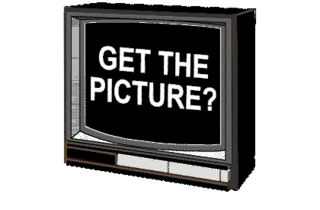 I was reading an article about Producer David E. Kelley, the man behind such television hits as L.A. Law, The Practice, Ally McBeal, and most recently, Boston Legal. He said that when he worked on L.A. Law, there were 48 minutes of show and just 12 minutes of commercials. Today there are a little more than 41 minutes of show and nearly 19 minutes of commercials! I bet you didn’t even notice how much more of your time and attention has been turned over to the ware-hawking pimps of corporate America. I must admit, I didn’t notice. I imagine they did it slowly over the years – like that guy at your party who imperceptibly inches up the volume on your stereo so slowly you don’t even notice it’s even getting louder until the neighbors start banging broom handles against the wall.
I was reading an article about Producer David E. Kelley, the man behind such television hits as L.A. Law, The Practice, Ally McBeal, and most recently, Boston Legal. He said that when he worked on L.A. Law, there were 48 minutes of show and just 12 minutes of commercials. Today there are a little more than 41 minutes of show and nearly 19 minutes of commercials! I bet you didn’t even notice how much more of your time and attention has been turned over to the ware-hawking pimps of corporate America. I must admit, I didn’t notice. I imagine they did it slowly over the years – like that guy at your party who imperceptibly inches up the volume on your stereo so slowly you don’t even notice it’s even getting louder until the neighbors start banging broom handles against the wall.Kelley went on to say the decrease in show time makes it tougher to tell character-driven and emotional stories. No wonder TV sucks! Fantasy Island and ChiPs had 15% more time to tell their stories. Today, hour-long television dramas follow a five-act structure that typically allows for eight minutes of storytelling between commercial breaks. So a show today might look something like this: 2-8-4-8-4-8-4-8-4-8-2. And because these structures have become standard, you can’t even channel surf anymore. Every station takes a commercial break at the same time! It’s a conspiracy, and I don’t like it. Especially considering I pay a shitload of money to my cable company every month.
 I thought the whole point to PAYING for cable was so the content was paid for by ME and not advertisers. I understand why NBC has commercials – it’s a “free” station that can be accessed by anyone with a pair of knitting needles and some tin foil. They NEED corporate-sponsored programming to stay in business. But you can’t get ESPN unless you PAY for it through your cable company. So if you’re paying for it, why are there still commercials? I smell a segment for the evening news: “The Fleecing of America – how cable companies are double-dipping their way to huge profits.”
I thought the whole point to PAYING for cable was so the content was paid for by ME and not advertisers. I understand why NBC has commercials – it’s a “free” station that can be accessed by anyone with a pair of knitting needles and some tin foil. They NEED corporate-sponsored programming to stay in business. But you can’t get ESPN unless you PAY for it through your cable company. So if you’re paying for it, why are there still commercials? I smell a segment for the evening news: “The Fleecing of America – how cable companies are double-dipping their way to huge profits.” Where is all of my cable money going if not into the programming? It’s not going into the service, that’s for certain. My cable cuts out once a month because of something called “solar flares.” It usually happens without warning, and in the bottom of the ninth inning. And the last time my cable MODEM went down, they told me it would be almost two weeks before someone could come out and check the line. Try going without your Internet connection for two days, let alone two weeks. No can do. I think I’d do better without running water for two days than access to the web.
If a portion of my cable contribution each month is fed back to the cable networks, to subsidize the revenue they glean from advertisers, then shouldn't I expect an improvement in the quality of the programming? More money means more to watch, right? I feel someone should be paying ME to watch half the crap on television these days, starting with anything original on USA.
Remember ONTV? It was a pay service that required a descrambler device. There were no commercials with ONTV. Television was free and paid for by sponsors, while ONTV was commercial-free because programming was paid for by you. Not these days. These days we all pay to sit through commercials. What's the deal with that?
Back in college, the roommates and I pooled our cash and bucked up for cable. It provided better reception and a wider selection of channels for a nominal fee of somewhere in the neighborhood of $10 a month. Of course, taxes and fees brought the bill closer to $18, but that’s life in the nickel-and-dime age. Even then, I remember most of the cable channels had commercials, but I didn’t mind so much because I was only shelling out $10 a month. And that was worth it to be able to get re-runs of Cheers at three different times every single day of the week.
 Today, the cost of cable is nearly five times what it was just a short time ago – and what do we get for it? Five times more channels, most of them offering crap programming than you will never watch, and all of them with commercial advertisements. If you want to watch movies without interruptions, you have to order the “pay” channels. But technically, and presuming you're not stealing cable from your neighbor, aren't ALL cable channels pay channels? So HBO and Showtime are really “pay MORE” channels.
Today, the cost of cable is nearly five times what it was just a short time ago – and what do we get for it? Five times more channels, most of them offering crap programming than you will never watch, and all of them with commercial advertisements. If you want to watch movies without interruptions, you have to order the “pay” channels. But technically, and presuming you're not stealing cable from your neighbor, aren't ALL cable channels pay channels? So HBO and Showtime are really “pay MORE” channels. I recently programmed my television to skip the channels I don’t watch because I was sick of wading through cartoons and gardening expos and home shop-a-thons. I now have my list narrowed down to around 20 channels. I figure if I can’t find something to watch on 20 channels, I've got a problem access to 200 more channels isn’t going to solve.
Today there’s the Dish network, and TiVo, and pay-per-view movies. It’s all too much to consider! Do I get a dish? Do I have the right exposure to even own one? What if I move? How much is it really (after the attractive promotional offer ends)? Will I get local channels? How much more of my free time do I need to hand over to my television for TiVo to make sense? How can I justify increasing the size of my already inflated cable bill by buying movies on-demand? Aren’t I better off joining Netflix or something? Isn’t there more to life than what’s on TV?
But now I’m guilty of digression…
All I really wanted to say is that I don't like the idea of paying to watch commercials.



1 comment:
When you want to change your system or upgrade to Hi-Def, let me know...I can answer most, if not all your questions. Sorta my thing, you know? Tech stuff......take care..PeterN
Post a Comment